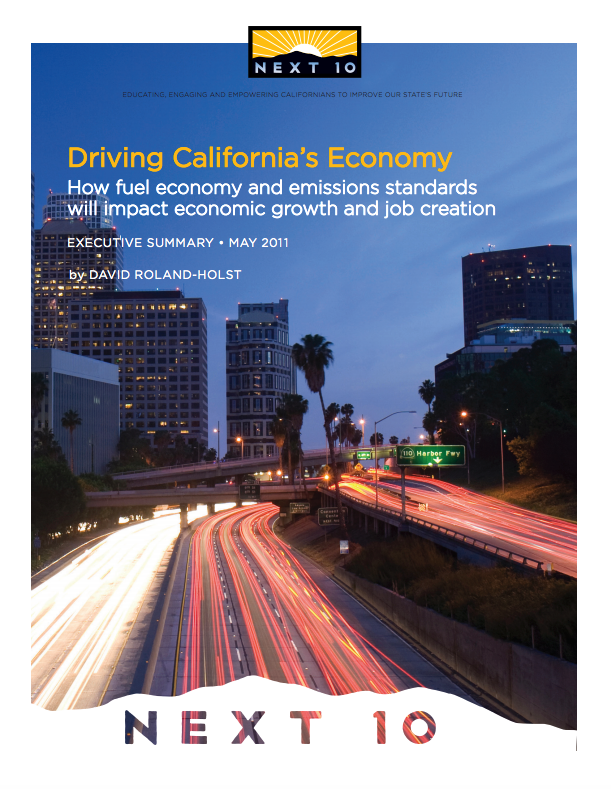Publications
Driving California's Economy: How Fuel Economy and Emissions Standards Will Impact Economic Growth and Job Creation
New study released by Next 10 finds that strong fuel economy standards and vehicle emissions standards will drive economic growth—and the stronger the standard, the greater the growth. Essentially, policies that put cleaner, more fuel-efficient cars, trucks, and SUVs on California's roads will drive consumer savings, spark job creation, and spur economic growth.
Driving California's Economy uses a state-of-the-art economic forecasting model to project the effects of a range of possible fuel economy and emissions standards now being considered by the state and federal government. When compared to California's economic performance in the absence of any vehicle fuel economy or emissions standards, if the federal government increases fuel economy standards by 4-6 percent per year starting in 2017, California would see the following impacts by the year 2025:
- The addition of 38,000 to 236,000 jobs
- An increase in GSP of .82 percent to 1.31 percent
- A reduction of 8 percent to 19 percent of total GHG emissions
- A cleaner, more efficient passenger vehicle fleet creates significant consumer savings. Savings are reinvested into local economies—a potent catalyst for economic growth.
- By reducing fuel use, cleaner, more efficient vehicles save families and businesses money. These savings tend to be spent on goods and services that are less import-dependent and more job-intensive; therefore, they have stronger “multiplier” effects in state, and create more jobs than they displace.
- Increasing fuel economy and decreasing emissions from passenger vehicles creates jobs across the economy, far beyond what are thought of as “green” sector and “green collar” jobs.
- An added benefit: the majority of jobs created by fuel economy savings are in-state service jobs, which cannot be outsourced.
- Clean car technologies that act to reduce GHG emission intensity and increase fuel economy are a source of economic growth, job creation, and lower energy costs.
- As standards at the federal and state level steer the state’s vehicle fleet toward ever-greater fuel efficiency and lower emissions, pressure on long-term California energy prices will be reduced, cutting future household energy costs and boosting energy security for all consumers.
- Vehicle fuel economy and emissions standards will lower household energy costs even for those who hold on to their gas-guzzlers.
- A cleaner, more fuel-efficient vehicle fleet reduces pressure on long-term California energy prices, bringing prices down below business-as-usual projections.
- The observed “rebound” effect, which refers to more driving in response to lower energy prices, is very modest in California.
- Our results show that the rebound effect amounts to less than ten percent of net fuel savings from federal fuel economy standards, leaving the bulk of benefits to California’s economy intact.
- The observed “rebound” effect, which refers to more driving in response to lower energy prices, is very modest in California.
- Our results show that the rebound effect amounts to less than ten percent of net fuel savings from federal fuel economy standards, leaving the bulk of benefits to California’s economy intact.
